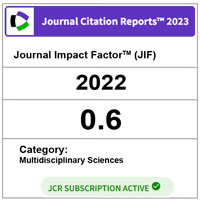Pre-drilling and self-drilling pins screw-bone fixation stress interaction analysis induced by uniaxial compression loading
DOI:
https://doi.org/10.11113/mjfas.v15n2019.1006Keywords:
Three-dimensional, Uniaxial external fixator, Finite Element AnalysisAbstract
A newly designed Uniaxial external fixator which functions as a universal fixator in the application of all types of bone fractures is recently introduced by both Hospital Universiti Kebangsaan Malaysia (HUKM) and Universiti Malaysia Perlis (UniMAP). The Investigation is focused on identifying and measuring the performance in terms of strength or weakness of the fixator that is needed before the application to the human body. Hence, this research was conducted to determine the performance of Uniaxial external fixator which was based on geometry using different screw drilling techniques applied during an angled uniaxial compression load. A three-dimensional fixator-bone was constructed using different screw inserting techniques which was then converted into ANSYS v14.5 for the purposes of conducting a finite element analysis (FEA). Axial compressive loading with various degrees from 60 to 6300 N were applied to bone models to stimulate patient’s daily activities while 10 to 100 N were applied to fixator models for the purposes of reviewing environmental loading to fixator-bone models. Findings revealed that maximum magnitude which caused deformation for predrilling and self-drilling models were located at the highest pin-bone interaction. Conversely, the maximum magnitude of the von Mises strain and stress was located at the lowest pin-bone interaction by omitting the existence of fixator for both Case 1 and 2. There was no obvious difference in the comparison of both models in terms of deformation. However, predrilling models have higher strain and stress than self-drilling models. In sum, findings indicated that self-drilling models have better performance compared to the predrilling models.
References
H. Mehboob and S. H. Chang, “Application of composites to orthopedic prostheses for effective bone healing : A review,” Compos. Struct., vol. 118, pp. 328–341, 2014.
M. H. Ramlee, M. R. Abdul Kadir, M. R. Murali, and T. Kamarul, “Finite element analysis of three commonly used external fixation devices for treating Type III pilon fractures,” Med. Eng. Phys., vol. 36, no. 10, pp. 1322–1330, 2014.
M. S. Taljanovic, M. D. Jones, J. T. Ruth, J. B. Benjamin, J. E. Sheppard, and B. Tim, “Fracture Fixation,” Radio Graph., vol. 23, no. 6, pp. 1–13, 2003.
“Nonunions,” American Academy of Orthopaedic Surgeons, 2014.
J. F. Barwick and P. J. Nowotarski, “Femur Shaft Fractures ( Broken Thighbone ),” American Academy of Orthopaedic Surgeons, 2011.
C. Ma, C. Wu, J. Jiang, Y. Tu, and T. Lin, “Metaphyseal locking plate as an external fi xator for open tibial fracture : Clinical outcomes and biomechanical assessment,” Int. J. Care Inj., no. 8, 2016.
C. Yang, H. Wang, Q. Zhu, and J. Zhu, “External fixator followed by a plate for distraction , reduction , and fixation in neglected femoral diaphyseal fractures,” Int. J. Care Inj., vol. 44, pp. 1087–1091, 2013.
C. Gwinner, S. Märdian, T. Dröge, M. Schulze, M. J. Raschke, and R. Stange, “Bicortical screw fixation provides superior biomechanical stability but devastating failure modes in periprosthetic femur fracture care using locking plates,” Int. Orthop., vol. 39, no. 9, pp. 1749–1755, 2015.
F. E. Donaldson, P. Pankaj, and A. H. R. W. Simpson, “Bone properties affect loosening of half-pin external fixators at the pin-bone interface,” Injury, vol. 43, no. 10, pp. 1764–1770, 2012.
P. Ausiello, P. Franciosa, M. Martorelli, and D. C. Watts, “Effects of thread features in osseo-integrated titanium implants using a statistics-based finite element method,” Dent. Mater., vol. 28, no. 8, pp. 919–927, 2012.
D. Höntzsch, P. V Giannoudis, H. C. Pape, and M. Schütz, “Basic technique : Modular external fixation,” AO Foundation, 2016. [Online]. Available: https://www2.aofoundation.org/wps/portal/!ut/p/a1/jU_JDoIwFPyaXukD4xJvPShxSYjBBXsxJZZCgm3zWiT69SJnXOY2k5nJDOU0o1yLe6WEr4wW9ZvzySVKAOJVCpsk2YfA0kUYH5cAsBt3hvMXA5v-l4cPYPArv6Zc1Sbvp56ZzkczRTnKQqLEoMFOLr23bk6AQNu2USBMYRp97Q8GBlUnW0fAGvSiJuAaVBIfQ22lcZ5mgyXU3.
H. Dankward and B. Suthorn, “AO Surgery Reference,” AO Surgery Reference, 2016. [Online]. Available: https://www2.aofoundation.org.
C. Colton and J. Orson, “Screws ─ Form and function,” AO Trauma, 2012. [Online]. Available: https://aotrauma.aofoundation.org/Structure/education/educational-programs/operating-room-personnel/Documents/Screws_Handout.pdf.
G. P. de Jesus, L. G. Vaz, M. F. R. Gabrielli, L. A. Passeri, T. V. Oliveira, P. Y. Noritomi, and P. Jürgens, “Finite element evaluation of three methods of stable fixation of condyle base fractures,” Int. J. Oral Maxilloficial Surg., vol. 43, pp. 1251–1256, 2014.
O. Eraslan and Ö. Inan, “The effect of thread design on stress distribution in a solid screw implant: A 3D finite element analysis,” Clin. Oral Investig., vol. 14, no. 4, pp. 411–416, 2010.
W. B. Edwards, J. C. Gillette, J. M. Thomas, and T. R. Derrick, “Internal femoral forces and moments during running: Implications for stress fracture development,” Clin. Biomech., vol. 23, no. 10, pp. 1269–1278, 2008.
S. J. G. Taylor, P. S. Walker, J. S. Perry, S. R. Cannon, and R. Woledge, “The forces in the distal femur and the knee during walking and other activities measured by telemetry,” J. Arthroplasty, vol. 13, no. 4, pp. 428–435, 1998.
K. Haase and G. Rouhi, “Prediction of stress shielding around an orthopedic screw: Using stress and strain energy density as mechanical stimuli,” Comput. Biol. Med., vol. 43, no. 11, p. 17481757, 2013.
R. Zdero, S. Shah, and P. Goshulak, “Surface Strain Gage Testing of Whole Bones and Implants,” Exp. Methods Orthop. Biomech., p. 385, 2017.
P. Bujtár, J. Simonovics, K. Váradi, G. K. B. Sándor, and C. M. E. Avery, “The biomechanical aspects of reconstruction for segmental defects of the mandible : A fi nite element study to assess the optimisation of plate and screw factors,” J. Cranio-Maxillofacial Surg., vol. 42, no. 6, pp. 855–862, 2014.







